In my opinion, the Voynich Manuscript’s nine rosette page has a bit of a problem with its pipes. However, to show you why I think so, I first need to take you on a journey through the rest of the Voynich Manuscript…
Q19A containers
Because of their visual similarity to the pipe tops, let’s start by working our way through all the container tops in Quire 19 (‘Q19’). Q19 is made up of two wide bifolios: every single container depicted in Q19 has what appears to be an open top (i.e. no lid or covering), giving them an initial feeling of having been meant to be bound together.
However, if you look carefully at the containers on the inner bifolio (f100+f101), you’ll see that these are all substantially simpler than the containers on the outer bifolio (f99+f102). This makes me strongly suspect that the containers on the inner bifolio were drawn first.
Hence I’ll start by going through the containers in the inner (simpler) bifolio, which I’ll call Q19A (f100+f101). These container tops all appear to have been filled in with faded light yellow paint, that I think is typical of the earliest stages of construction; there is no sign of vertical parallel hatching; some have rows of dots around them; all are very simple.
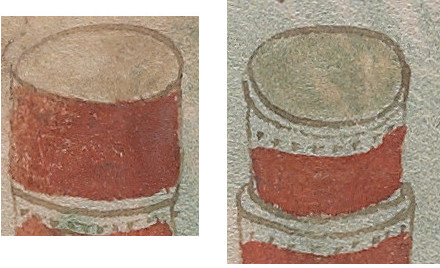
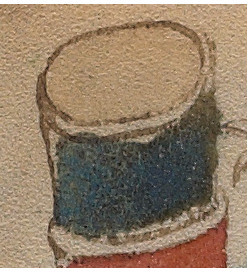
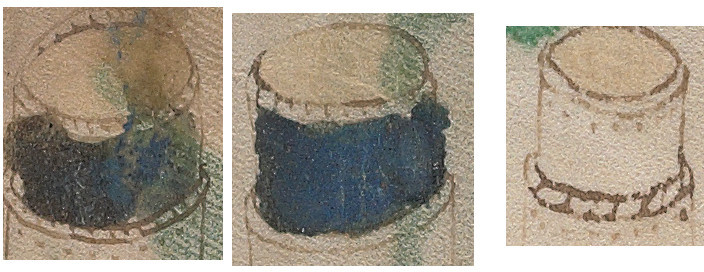
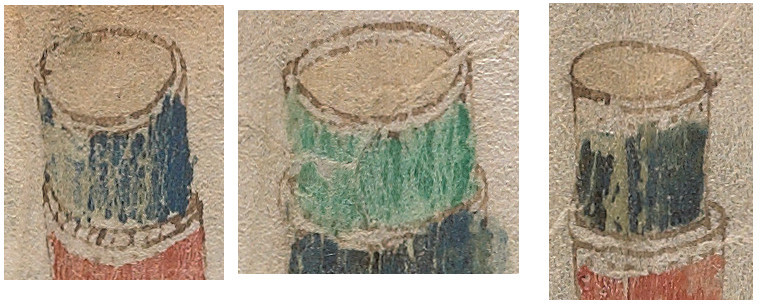
Q19B containers
Contrast the preceding Q19A containers (f100+f101) with the Q19B containers (f99+f102) bound around them. These containers start simple (in fact, almost exactly as simple as all the Q19A containers), but quickly grow in complexity. Rows of dots ‘inside’ the container neck on f99 morph into vertical parallel hatching by f102r1: while the parallel hatching starts by yielding to the surface of a liquid in the container (f102r1), before finally going all the way down the neck of the container on f102v2:

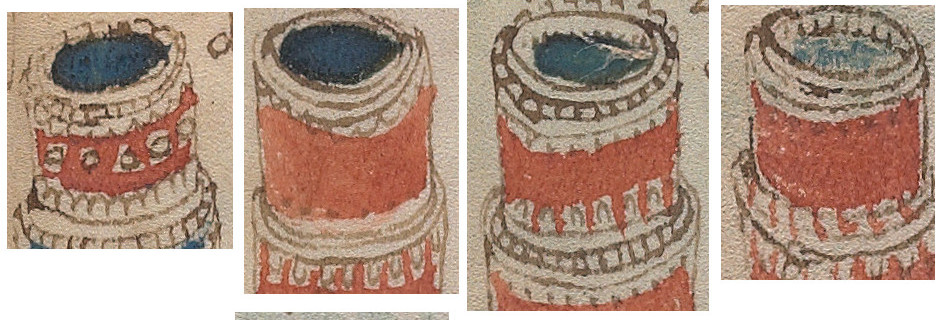
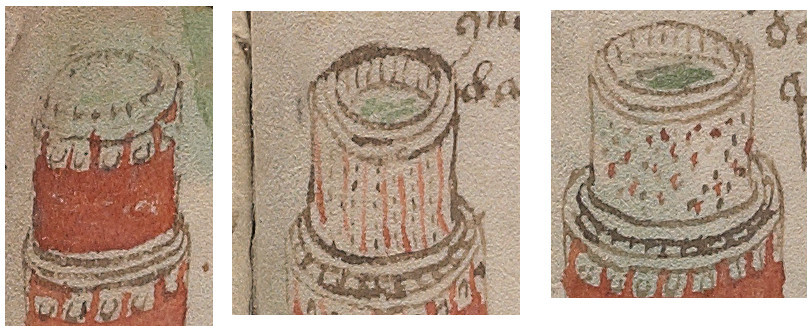

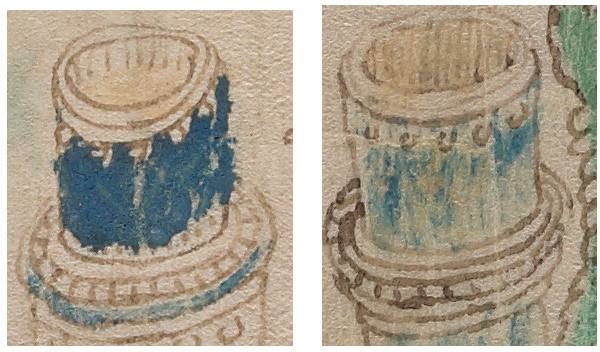
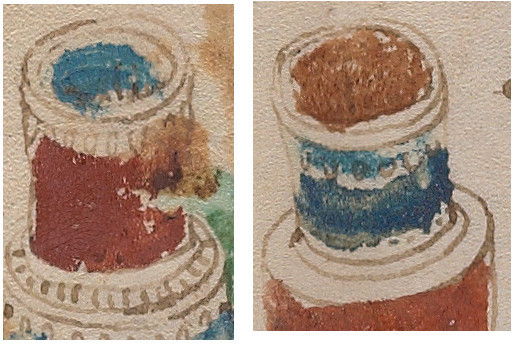
Q15 containers
More than a decade ago, I argued that Q15 was almost certainly intended to have been read after Q19. This was because there is an ever-increasing complexity to the depictions of containers in both quires, growing from simple open-topped containers at the start of Q19 (as above) to Byzantine (and almost impossible to actually construct) containers by the end of Q15.
You can see the direct visual continuity between the last page of Q19 (f102v) and the first page of Q15 (f88r) here (clearly these two were overpainted by different people, using different quality inks and indeed paint strokes):
Q15 has only one open-topped container (top left of f88r, right at the start of the quire), while all Q15’s other containers appear to have lids, again supporting the idea that this top left container marks a kind of hand-over point between Q19 and Q15:
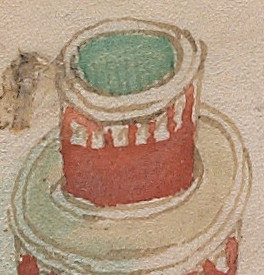
Here we can see full-height vertical parallel hatching inside the container neck (as per the hatching on f102v2), yet another indication that Q15 should probably be read as following Q19B.
Pipe evolution
I believe the way that these pipes are drawn may well be telling us a story about how the manuscript was constructed, e.g. the order of construction (Q19A, then Q19B, then Q15). We’ll use this basic model shortly as a lens to take a fresh look at the nine rosette page’s pipe drawings.
Furthermore, I think it would be interesting to look again at the text patterns on the (Currier A) pharma pages to see if they too follow some kind of evolutionary path mirroring the pipe evolution sequence. The pipes would seem to predict that Herbal A -> Q19A -> Q19B -> Q15.
Marginalia container
We can use our new micro-model to take another look at the container that is part of the f66r marginalia:
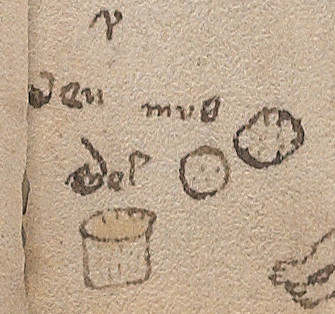
Here we can see the hint of sketchy dots or vertical hatching going down to a painted liquid surface, which would seem to date the marginalia to around the time of the Q19A / Q19B writing phases.
Oddly, f66r is a Currier B page: which would seem to imply that the Currier B on f66r may well have been written before the Currier A on the Q19B bifolio. Something to think about, then.
The NW rosette pipes
OK, so now we’re ready to move onto the nine rosette page (I’ll leave the odd pipes in Q13A and the Pisces/Aries tubs for another day, this is already too long a post).
Let’s start with the single set of pipes in the NW rosette:
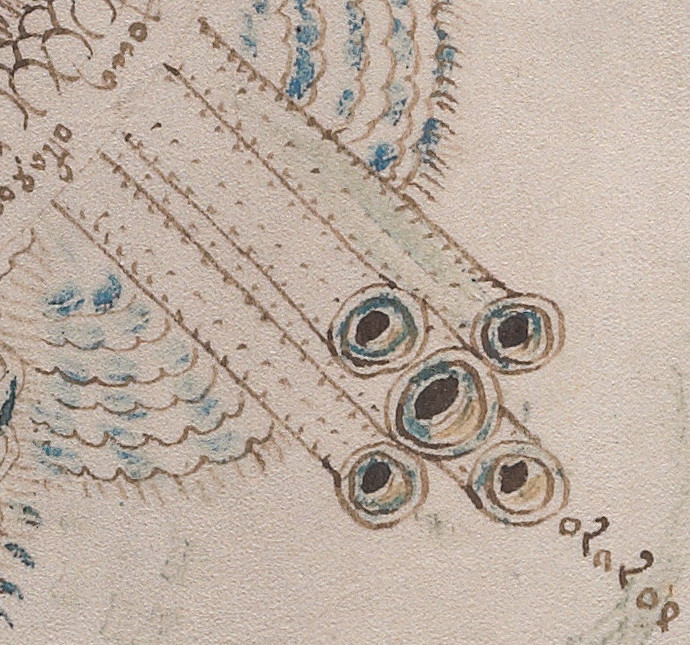
It shouldn’t be hard to see that these pipes have a fair few drawing issues. For a start, the pipe ends are circles, not perspective-style ovals. Also, you can see traces of faint yellow paint inside the circles (none of the other pipes have this). It also looks to me as though the dark areas in the middle have been added over the top of the blue paint. And yet the blue paint on the top left circle seems to have been painted on top of the inner circle.
Further, there are no parallel markings or rows of dots on the inside of the pipes. I’m also not at all clear about the codicological relationship between the blue and yellow paint: I suspect the faint yellow paint was put down first, and then the blue on top at a different time.
Compare these with a typical cluster of pipes from the central rosette:
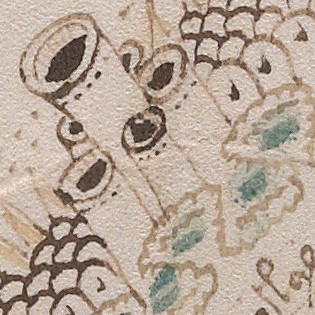
Here, there’s no colour in the pipes at all: there’s (faint) evidence of parallel hatching down the inner back wall of the pipe. The rear pipes of the group are occluded by the dominant central pipe: there are rows of dots along the outside of most of the pipes, just below the front edge of the top rim. The side edges of the pipes are also lined up well with the side edges of the top rims.
It may not be a comfortable starting point, but I can’t easily equate the pipes attached to the NW rosette with the pipes attched to the central rosette. My belief is therefore that the five circles in the NW rosette were originally drawn as free-standing circles (and please don’t ask me what this pattern means, because I don’t know), and that the pipe bodies (and the five central dark areas inside the circular ends, to make them resemble pipe tops) connecting them to the rosette were added afterwards.
Moreover, I suspect that the bodging to the NW rosette’s circles to turn them into pipes was done around the time of the Q19A (simple container layer), while the sophisticated ‘fantasia’ pipes added to the central rosette were probably added after the Q19B/Q15 container layer.
I think this also implies that the pipes all around the central rosette don’t have any actual meaning, but were rather added to try to draw attention away from the five fake pipes in the NW rosette. So, of all the pipework drawings on the nine rosette page, only the five circles (at most) had some kind of actual meaning, while the rest of the pipework there would seem to be decoration and/or distraction.
The other story this seems to be telling is that there was not a simple do-a-single-section-and-then-move-on approach to the construction of the Voynich Manuscript: rather, that multiple layers were added and updated at different times, i.e. with a somewhat more reflective and adaptive mindset.
That is, it would seem that the VMs was not a simple fire-and-forget project, but instead something that involved a lot of thought and practical finessing over a period of time. Quite why it needed so much refinement and empirical subtlety I have no idea: but it is what it is.
Wolkenband Layering
If we look at the bridge between the N rosette and the central rosette, I think we can see at least one type of layering quite clearly:

And no, I don’t think that these are simply an artifact of the scribe sharpening his or her quill, or starting a fresh batch of iron gall ink. I’ll specifically highlight the two layers here:
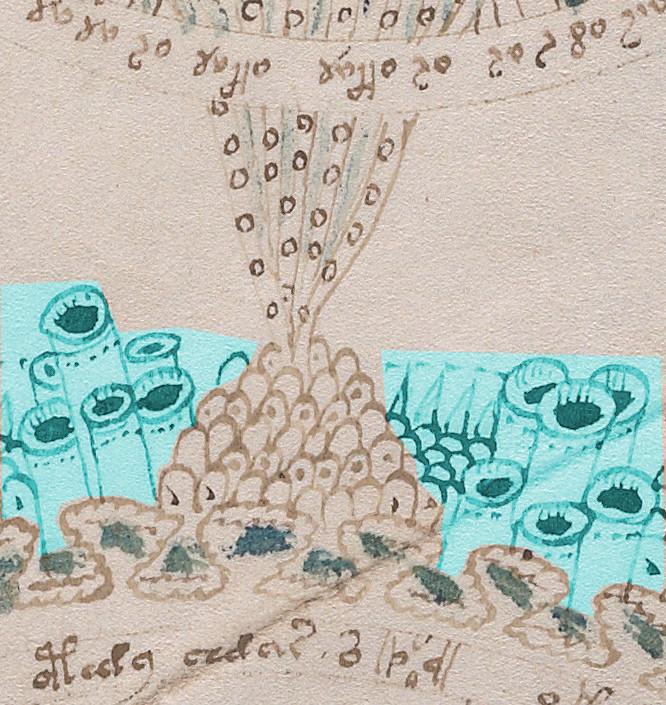
That is, I think that the original outside edge of the central rosette was the wolkenband ‘cloud’ motif (which is, after all, what wolkenbanden signified, i.e. a kind of liminal edge between levels or worlds): and that the pipes around the central rosette were added as part of a separate phase.
This would mean that the central rosette started out as essentially just the exploding onion domes and the wolkenband outer ring: everything else there would seem to be surplus decoration. The north-west rosette too would seem to have originally contained be little more than a series of 37 crescent moons, plus a mysterious set of five circles outside it. (Note that the blue contact transfers near the centre of the NW rosette appear to me to have come from the SW rosette, rather than from a facing herbal or pharma page etc.)
Please understand that I don’t know why any of this should be, I’m merely documenting what I find.

Nick: Obviously the nine rosette, five pipes formation can not possibly be metal castings, damascussed steel renderings nor moulded clay, so the only materials available would seem to be naturally formed plant or animal parts, unless it’s something else inspired possibly by pure imagination. I’m thinking that the blue/yellow shadings could simply represent an angled and slightly elevated view aspect. Not much help, though all I really wanted to say was that your post is pretty dambed impressive for a Voynich amateur!…
Nick: There is a notion that you put forward, which may be right, that the more complex representations of containers must have been drawn later as they are more sophisticated. An alternative possibility is precisely the opposite that the drawings of the containers got simpler over time. This could be as a result of laziness or just a sense that these more complex drawings were superfluous. I know this is the kind of thing I would do, for my sins, as I would lose interest in drawing the unnecessarily ornate containers. (I am not refering to the 9 rosette page in the previous remarks.)
More to come…
Nick: It is a good effort you are making and a valuable exercise that I definitely do not wish to deter you from, however it seems like there is a lot of “suspecting” and not an awful lot that is tangible in your analysis.
More to come…
Nick: As far as the details around the central rosette that you refer to if one looks at these details all around the central rosette very careful it seems clear that there is faint drawing intermingled with the fresh/bold pen strokes, which is not what one would expect if your theory is correct.
To me there is a much more prosaic explanation, simply that the author went over some of the more faint details, depending on how faint they were, with fresh ink.
More to come…
Mark: can you point me towards the “faint drawing” you are talking about? (Clock time, ring number etc.) A bit more than a dismissive shrug would be helpful. 😉
Nick: It makes most sense I think if I send you an email with an image attached with the relevant bits circled. It would be hard to explain in words. I will try to do this as soon as I am able.
I wasn’t trying to be dismissive of your efforts, I was just trying to state what I see.
Nick: A whole new perspective on what the pipes are supposed to represent in the theme of the nine rosettes fold-out are much better evidenced with the new blow-ups…..For some time I’ve been of the opinion that the map layout is a concept that revolves around a fairly small self contained spa resort, and not a community, city, state, country, continent, hemisphere or even the known world. In effect I’d be looking at a kind of post medieval, seasonal based, health and happiness facility, centred around it’s quite obvious, thermal spa baths. The pipes are of course purpose fashioned & hollowed wood, connecting hot water supply conduits which were intended supply fawcet outlets in those nymph infested bathing tubs…..I see a good artists impression that highlights best features of the health spa bathing facility, aerated ponds and a botanic garden, designed to encourage monied eco tourists. Fairly effective promo, if you can picture the idea in a period perspective and with a liitle down-to-earth imagination, ala Swiss family Robinson. Now we can zone in, by isolating all well chartered deep thermal steam seepages in a particular region of say, modern day Italy, Spain, Austria, Germany, France, or one of an hundred other little countries that are no longer (not Mexico or Patagonia). It should then be possible, by closer scrutiny of VM plants, clothing, structures and fauna (excluding pangolins and swallow tailed merlons)… I think the dots around the land bridge pipe nest tops, are wooden dowel securing posts for connecting with extension pipes, which would have been fairly standard up until quite recent times. I’m also inclined to the view that lengthwise dots on the NW pipes might well be thread joining tack points for an insulation system comprised of back to back sheep skin hosing, which would have served to keep flowing water hot and prevent freezing up when water flow has been shut down for servicing etc. Also still in use for gloves, ugg boots and kitchen hot pot mittens, so what do you say!..
John Sanders wrote: “For some time I’ve been of the opinion that the map layout is a concept that revolves around a fairly small self contained spa resort, and not a community, city, state, country, continent, hemisphere or even the known world. In effect I’d be looking at a kind of post medieval, seasonal based, health and happiness facility, centred around it’s quite obvious, thermal spa baths.”
I agree with this as a possibility. I haven’t had time to write it up, might never find the time (I wish), but I’ve suggested one of the places that the rosettes might represent is Naples, with the Island of Nisida on the top-right (rough water, a crater-like center, jetties connecting it to the mainland, and ruins of a castle on top all fit medieval Nisida). The “volcano” might be a fumorole crater top-left. Craggy winding paths in between, possibly with fountains or water wheels. So far, so good.
One of the most prominent fumorole areas in Naples is Campi Flegrei (mud baths, thermal baths, etc., before Pozzuoli was destroyed in the late medieval period), but there are several other thermally active craters nearby that are similar, so it may not be possible to pin it down a specific one.
The themes of pipes, water, “volcano”, craggy paths, river deltas, “rough water”, and even grottoes (as are depicted in the bathing scenes) fit Naples quite well. It wasn’t the only spa location, there were many all over Europe and beyond (far more than I realized), but it was one of the major ones and the southern boot is topologically similar to the rosettes page.
And I might as well say this too, since I don’t have time to blog all my research, but I don’t think the Byzantine tower top-right is a lighthouse or that the middle-right rosette is a compass rose (as were suggested by D. O’Donovan), but I think MAYBE the middle-right rosette could be an aerial view of a lighthouse (something no one else appears to have suggested). The other rosettes are a mixture of side and aerial views, with most of the side views being details and the aerial views being larger geographic features and I think this is an aerial view…
So, imagine the center of rosette 6 being a tall round tower, with two large triangular beams of light streaming out and a “cloud band” of foam and waves surrounding it, as is common for lighthouses that sit on rocky mounds that jut out into the water.
Okay, now look closely at edge of the “tower”, next to the beam… see the little lines? In modern cartoons, that symbol means sound, like a fog-horn sound. Guess what… In medieval drawings, lines like that also mean sound (I looked, to make sure, and was able to find examples). I wanted to blog about this and show the pictures, but I’m still trying to find time to write up my 2009 research and have finally accepted that I’ll never catch up, ever… so I’ll have to be content with simply mentioning it rather than explaining and diagramming it properly.
This idea doesn’t fully account for the Ghibelline merlons, but there were a few central Italian coastal cities that had the merlons at a fairly early date (I’m just not sure if it was early enough, which is part of the reason I haven’t 100% committed to this idea or written it up yet, because I wanted to find out for sure).
There were also some domed buildings in Naples at a reasonably early date (it was multicultural due to its prominent position on the Mediterranean). So more research is needed to confirm or deny these kinds of details, but there are some important overall similarities that I found intriguing. Naples isn’t my only idea (there are a couple of others that seem to fit quite well), but it’s on my Top-5 list.
Nick,
Just a small point – since about the 1930s, we’ve reduced the number of imported terms use in writing art-history. We’ve kept , keeping e.g. sgrafitto and (sometimes) still use chiaroscuro but I haven’t seen anyone except a Voynichero use the German word for a ‘cloud band’ in ages… unless they were writing in German, of course. Still, you are perfectly free to use the German, or the French (bande de nuage) or the Italian (banda di nuvole) or any other which takes your fancy. I just thought I’d let you know that a choice to use a non-English term is a little dusty – but cutely quaint – these days.
J.K. Peterson: I can well understand how Naples might come to mind and I would like to explore that possibility further, as well as a neighbouring region over the bay in Sicily. I am nevertherless rather keen on Padua and in particular the region of Colli Euganei with its side by side thermal villages of Abono & Bataglia at sea level below the foothills. Both had been famous for their spas pre the destructive Lombardo period around 600 AD but were re developed as resorts in the early 1400s with numerous canals serving all points to Venice and the Adriatic. There were fifteen close independent communes within ten to fifteen kilometres of the capital Padua and most had views to Venice itself which must have been quite a remarkable vista. The ultra pesimistic poet Shelley gave the setting rave revues, refering to the villes as his idylic islands on the plains of Lomardo. Even a young author named Ethel Boole choose the nearby foothills, as a part setting for her novel ‘The Gadfly’, written during her vacation to the region between 1895 and 1896. As stated that locality would be just one of perhaps many possibilities for some entrepeneurial type to come up with the idea of a pictorial almanac detailing it’s many virtues. Such a pity that he wrote the script in ancient Czechoslovakian that is according to our irrepressable Prof. Josef, the ANTi man who should not be taken lightly by any means.
The rosette is not one of my interests. I have never really dealt with it either. But I think, based on the overall picture of the book, that it is something that concerns health.
My work on the plants is almost complete.
The possible place of origin is still in work. That means there are a few more hints, and a little more detail.
For 2019 I will dedicate myself to the text. I think I’m on the trail, at least I have not run against a wall yet.
In the middle of the rosette on the right, he writes to the left of the center ….
( a certum narum a at itis enus )
I have no idea what he means, but maybe it will help you.
Nick: I have done much of the tedious task of highlighting the distinction between the bold(darker/stronger) ink and the more faint. The more faint writing is in bright red and the bolder is now in bright blue, so they can easily be distinguished.
If your theory were true the distinction between the later added drawing and the faint existing drawing would be very clear. As it is the faint drawing and the bold drawing are in certain places intermixed and so it merely looks like the author has gone over some particularly faint drawing with a bolder pen and fresh ink.
I am sure we can and probably will get into the minutiae, but I think the situation is pretty.
John wrote: “I can well understand how Naples might come to mind and I would like to explore that possibility further, as well as a neighbouring region over the bay in Sicily.”
Yes, I agree with this as well. In fact, there is a churning whorl of water in the strait between Sicily and Italy that MIGHT account for the “rough water” and spiral in the top right rosette, and yes, there are other features that fit well (including a volcano).
I explored this area extensively, trying to find old maps and descriptions, but it’s VERY hard to know what it used to look like (impossible, actually), because Mother Nature completely re-engineered the northeast coastline and obliterated most of the town that was there in the Middle Ages.
Despite the difficulty of researching it, that area is also on my list.
JKP & JS: Why stop there? You could go as far as Tunisia or even the Sahara desert. Personally, I’ll stick to the North.
Nick: I think you are probably reading too much into the various details. It is a sound endeavour you have undertaken, but I think there is still some way for you to go.
If this sounds dismissive I would point you to your comments regarding my ideas about the sequence in which various rosettes and causeways were drawn.
Mark: the key thing about microhistories is that they can easily run in parallel – my suggestions about how certain parts of the page were drawn aren’t necessarily in conflict with what you propose for other parts of the same page. Ultimately, it should just be viewing the same object through a quite different historical lens: so there should be no need for dismissiveness.
Mark: I know that your comment on more acceptable norther locality was well intended and you can be assured that Sahara would compare with Nahuatland or outer Mongolia on my personal list of likely fishing holes…I was looking at Sicily as having all the necessary ingredients to compliment the typuca Italian theme along with a temerate, more amenable, (Mediterranean flora) climate. To my way of thinking the whole VM theme was likely to have been a fanciful, virtual reality show (scenes we’d like to see). So any locality that encompasses all seasons and various varieties of known flora and fauna would pass muster. Somewhere in a past life, I was involved in aquaculture, so was able to identify, the stand out features of blade aerated fish ponds on the ‘rosette’ page. Any half trained Italian inventor of a certain period would have been capable of engineering a system to harness sub terranean thermal energy for running geared fan blades, piping off perennial hot spa water and all sorts of wonderful steam driven contraptions for his ‘health and happiness’ Disneyland theme park promo (VM)…Nick: Could your exploding onions be spent magma rocks, through which sulphurous particled steam vapours are passing…Are you familiar with the Sforza tarrot judgement card depicting the nude, blonde bathing nyphs and the dirty old muff diver circa. 1460?…
I don’t see anything wrong with what Nick is doing. Even if an idea turns out to be wrong, systematically working through the patterns sometimes encourages a different perspective, or brings things to our attention that we might otherwise have overlooked.
OK so the wide bladed fan for breaking up surface water to enhance oxygen input, is obviously a little over the top, I wholeheartedly agree, but crikeys even Leonardo da Caprio’s sketches are a little on the imaginative side, especially the galleon with flapping wings…Was there ever any concensus on the key to the little f66r jotting, apart from that it featured a bucket, potato and sponge along side a body, as It seems to have been entered in the margin for a very sound reason. One wonders if it could provide some vital clue in the scheme of things, if only we could figure what the dickens it and it’s accompanying notation was intended to represent.
Nick: I am all in favour of people asking questions, developing lines of thought or argument and so I very much support you in that.
Regarding theories in general with no specific reference to this post of yours I would say that->
As I have recently stated I am very happy with people developing new theories even if they are ones I think completely wrongheaded as they can be an indirect aid in the development of other theories. Whether, as you have pointed out, because one can learn from what they have got right or what they have got wrong. The least interesting theories from my perspective are ones that are just a rehash of other already existing theories. So when it comes to theories other than my own I am increasingly tolerant as I can see use or value to them. So in general in most instances I am inclined towards the view that a bad theory is more valuable than no theory. Who knows someone might have or may in the future stumble on the right answer even if they do so for the wrong reasons?
As I have stated I appreciate that it must be somewhat trying to be distracted from your research to address another arguably half-baked crackpot theory, but for me I am interested in the theories of Mr Sheeger or D O’Donovan(though unfortunately these are now inaccessible) or Juergen Wastl or Claudette Cohen etc.
Yes in some cases it has more to do with what I think they have gotten wrong than right, but even that does not make them of no practical value.
Mark: on the one hand, these theories (as you see it) have marginal value, partly for the evidence they drum up in support of their wrong-headed ideas but also as good examples of how not to form theories. Yet it would be a foolish Voynichian who sought to reach truth by eliminating all the stupidities: for there is no practical end to them. They are “a gift that keeps on giving”. 🙁
Nick: I, obviously, want to avoid a semantic discussion as to whether the term “theory” is the correct term or whether “hypothesis”, “idea” etc. would better categorise these. Inevitably we have different perspectives on this subject, which is probably as it should be. Anyway I guess we have to ask the question as to what Voynich tomfoolery(certainly from your perspective) the New Year will bring. What new theories could be lurking out there ready to appall us? What has hitherto not been suggested? A Scottish Gaelic Voynich theory?
Mark: just so you know, I tend to use “theory” for those hypotheses that are presented with an ideological, almost religious fire burning in the theorist’s eye, a fire that no mere fact or internal contradiction could dim or douse.
There are a few Voynich hypotheses, sure: but they’re vastly outnumbered by the Voynich theories.
Mark: oh, and there is almost no Voynich theory so ridiculous that it hasn’t been proposed straight-faced by a nutter on YouTube sitting in his underwear on a shabby sofa, smoking a spliff.
I love ideas.
The idea:
I decode the book.
The theory:
I’ll do it in 2019.
The result:
I will not tell you.
The reason:
You shouldn’t take people’s faith in fairy tales. 🙂
In the Central Rosette, let’s consider the matter of why the pipes are present. Imagine the illustration with the pipes removed. This leaves the encircling design of the wolkenband (cloud band) much more exposed. And consequently more easily seen and *recognized* as a cloud band. So where do we find other examples contemporary with the parchment dates? Mostly in medieval European art.
Let’s also look more closely at the structure of this VMs cloud band. It is fairly close in structure with the scallop-shell pattern used in various images. It is based on a nebuly line structure. However, where many scallop-shell representations have the scalloped areas only at the crests and troughs, with regular lines making up the sides, the VMs has this running engrailed / invected line pattern throughout. There is also blue paint in the VMs rendition.
Some noted examples of scallop-shell patterns include certain books from Christine de Pizan, the Apocalypse Tapestry, and the cosmic illustration of BNF Fr. 565. This is interesting because this cosmic illustration has been used in a comparison with the VMs “cosmos” of f68v3. One of the ‘apparent’ shortcomings of the comparison is the visual differences between the delicate cloud band of BNF Fr. 565 and the running nebuly line in combination with the wheel and curved spokes in the outer parts of the VMs illustration. Nevertheless, both the cloud band and the nebuly line present with 43 undulations and there is a clear etymological connect between the terms nebuly and cloudy.
As to the wheel and spokes of the VMs illustration, these are all examples which contain a line of text. Ask yourself about the substantive, representational reality of text banners in medieval images. While these structures are informative to the reader, they can only be seen as ephemeral rather than actual objects. What if this also applies to the VMs cosmos? What if these text bands are present only to create visual dissimilarity, but do not alter the actual cosmic structure?
One apparent weakness of the cosmic comparison is based on the on these visual differences. Looking at VMs f68v3 it might be thought that the artist didn’t know, couldn’t draw the proper type of wolkenband. But the cloud band in the Central Rosette shows this is not so. And rather than make this too easily discovered, the pipes help to disguise the cloud band.
Interesting as well is a second, *paired* cloud band in the Center Right Rosette.
The structure of this second example is unusual in that the nebuly line structure is fancy on the outside and plain on the inside. This type of structure seems to be rather uncommon, but has shown up in a few examples.
Nick,
One of the most interesting questions about the manuscript’s drawings for me – that is in terms of art history and iconographic analysis – is that of perspective.
In the main (e.g. in the botanical imagery), it is evident that the person/s who first drew those images had little sense of perspective-drawing in either the Asian or the Renaissance western style.
However, the ‘pipes’ (as you call them) appear to show something more.. less in the containers than in the tower-sort of pipe. This is most notable in the sets you describe as being in the north-west (which they would be if the map were arranged as we’re used to seeing North oriented maps). However, the hill-top rising of the sun in that corner, opposite the headlong descent of the sun in the opposite corner, does seem to me a clear indication of reversal from our present habits. But the point is that they do show an awareness of how to represent depth. The question I’ve yet to settle to my satisfaction is whether that’s an imposition by the fifteenth-century copyists (presumably in Italy), or not.
As you probably know, other means to indicate perspective (or better, depth) were used in other parts of the world. Just as example, the Chinese have the further plane wider than the nearer. One might interpret some of the other pipes that way, but because the draughtsman began with what is almost a circle, it’s difficult to know whether the detail indicates one or other – or some other – tradition.
We differ over the reason for relative simplicity or complexity in the containers; my own view (matched by physical and historical examples) is that they represent a range of similarly more- and less-complex containers. But I daresay we’ll have to agree to differ on that point.
Diane: the point of the post was to argue why I think that the ‘pipes’ (for want of a better word for them) around the central rosette were added as a separate codicological layer around the cloud layer / wolkenband / whatever-you-want-to-call-it-you-know-what-I’m-talking-about, and that the specific detailing of those pipes would seem to imply a non-straightforward construction order for all the perspective-style container/pipe drawings throughout the manuscript, which would seem to be quite different from a straightforward ‘copy job’.
And indeed it may well be that these perspective-informed drawings that appear in so many places can be used to date it as not earlier than, say, 1425 or so: which isn’t exactly a million miles from what I have long said the parallel hatching tells us.
The problem then is that if you take away all the fifteenth century stylistics, not much remains: even the zodiac roundel drawings that I long took to be more attuned with the late 14th century now turn out to be more typical of the 1410-1420 period – the simple round neck lines, the sleeves, even the crossbow (though you have your own interpretation of that) – though built on elements of the late 14th century. And (of course) books on balneology were a particularly fifteenth century thing, as were semi-naturalistic herbals and books of secrets.
So: even though we end up with a view of the Voynich Manuscript that is closer to a patchwork of pieces, those pieces all seem to have been plucked from what was in the air in the first half of the 15th century, and with a remarkable consistency.
I know that your position has long been that the contents of the Voynich Manuscript hark back to much older (even Classical) exemplars and ideas: but for me, the more we come to know about it, the narrower the possible date range for its composition becomes. Whatever the radiocarbon dating may say (or be interpreted to say), I struggle to put its dates both of construction and of composition any earlier than about 1440.
Nick,
I see what you mean about the darker ink that has been used for the outer circuit of that ‘central land’ and its towers, but not why why it mightn’t represent just a new and better batch of ink – another ‘pass’ as you’d say.
I certainly wouldn’t over-state the *presence* of perspective in the manuscript – its overwhelming absence is more intriguing., and while one or two details suggest some effort to represent depth, overall – and especially in the botanical section – it’s quite lacking. These drawings are indeed, as Panofsky and Steele both observed, without sign of Renaissance.
I was noting, rather, a better skill reflected in some few details in indicating depth in a three-dimensional, hollow form. We find no worse facility in European Christian art by the tenth century or so.
It think it is certainly a bit of a struggle, sometimes, to remember that a great familiarity with this manuscript and its imagery only ‘normalises’ them in a subjective sense; it doesn’t make the content any less *unlike* European art to 1438.
If it were otherwise, Newbold would not have needed to invent his ‘categories’ or, had they been right, should someone later substitute for ‘biological’, ‘balneological’ etc In both cases, what has happened is that after presuming the content could only be the cultural expression of a Latin (western EUropean) Christian, manuscripts of that sort were hunted (usually only in a pet region: England, France or Germany etc.) for something the hunter thought ‘like’.
But from my point of view ,most of the supposed ‘matches’ are on the level of..
” I think the manuscript is Libyan. The manuscript has a cat. Here’s a ‘match’ in a picture of a Libyan cat… ergo, I was right. It’s Libyan.”
However, to think positively..
I’m really interested in what you say about the calendar diagrams – have matches been found for the diagrams as a whole… or just sort-of matches for the central emblems (which, as I’ve said all along, do speak the language of Mediterranean and western Christian art).
And of course the other question, constantly ignored, is that of intended significance; the shared perception of the original maker/s and their intended audience. What did it mean to use the crossbowman rather than the centaur, or an ordinary bowman, or even just the simple image of a bow? What did it mean to put the bowman’s right hand in that curious position: obviously the draughtsman wasn’t incompetent: look at the detail included in that tiny central emblem. Whatever best explains the whole is the explanation I’m most inclined to accept.
Must say it’s nice to have a pleasant to-and-fro sort of conversation about the manuscript. One is so often made to feel that a different point of view marks one as a heretic.
Diane: the technical point of the post was that I think we can conclude from the different ways in which the pipes were rendered that the two layers around the central rosette were indeed added at separate times, though quite why that should have been the case is a separate issue. The cloud layer / wolkenband on the edge of the first layer is (almost by definition) such a clear way of defining an outer band that it can do little but support this idea.
I think the close set of matches between individual zodiac roundel drawings and the images used specifically by Diebold Lauber’s workshop, together with the round necklines (which seem typical of the 1420-1430 period) and the styling that is consistently different to the rest of the Voynich Manuscript all point to those drawings’ having been copied en masse from a German manuscript calendar from that region circa 1420-1430 that has probably not survived.
Again, quite why that should have been so is another matter entirely: all I’m saying is that it is what it is. I’m not sure that we have enough to be sure that any individual choice of drawing was imbued with particular significance: certainly, the drawings we see from that time and region seem to be somewhat arbitrary and chosen from previously-seen near-exemplars for their convenience rather than for their symbolic or iconographic content.
Nick, I see what you’re saying.
I thought Koen’s point, when he tracked the unusual *variation* on the ‘crayfish’Cancer (not so unusual in itself), was that the track seemed to lead to the earlier period: to copies of Cantimpre’s De naturis rerum, which then led to to the later copies of the German rendition, and from there (perhaps) to calendars produced in the same workshop as the latter.
I don’t want to sound too certain – Koen is in the middle of this research, still. But that’s my understanding of the material he’s published so far. Maybe he’ll see this and add a comment. 🙂
About the other point: I don’t quite see how you can establish the gap in time between the drawing of the cloudband line and the drawing of the outer ring that is in darker ink; seems to me it could be argued a five minute difference as easily as longer.. but I won’t prolong the conversation. I sense you’ve said all you need to.
Hi Nick et al,
I had considered the NW rosette pipes to stand for Portugal in terms of the relation of the pattern of five with the five shields in their coat of arms, and for the attachment to the NW rosette, which i had considered to stand for Ceuta, which Portugal took in 1415. I also had thought that the rosette also could be seen as standing for a larger area, being Morocco, with the Atlas mountains being described therein, outlining a barren area, the Sahara. I thought the crescents might be related to the Berbers, similar to the finials that can be seen on the tents in the Catalan Atlas in northwest Africa.
In reading JKP’s blog, I learned of the idea that the rosette can be thought to resemble a volcano. I looked up whether there were any in the general area, and it turned out to be the case that not only are there some in the middle Atlas, but there are mud volcanoes in the Albaran Sea off the east coast of Ceuta. Both of these findings fit well with the rosette representing Morocco-Algeria, with Ceuta being represented by the tubes. As in, the area that sticks out, when you view the general Morocco area as a circle. In a north based map, this promontory would be pointing north, or up, which it does in the manuscript if you align it with the writing directly below it.
The pipes would make sense in that way as there are several mud volcanoes there, explaining the multiple pipes. They would mix water from beneath the crust and sediments therein and spew them, this could explain the blue (spring water) and yellow (mud) mix colouration.
I have been seeing volcanoes everywhere in quire 13 lately, related to finials. There are finials on the central rosette as well, and i now believe it to represent not only an ethereal conglomeration of religious ideas in the vein of central Jerusalem on medieval maps, but the rock piles on the outer edges outside the cloud band now make me think it is also to depict a real place, and that would be Sicily, complete with its largest active European volcano, Etna. It is also very centrally located in the Mediterranean, in fact i don’t know why i hadn’t placed it there before, seems obvious to me now.
With Morocco et al as NW in the initial orientation of the rosettes, Europe as NE, with Vesuvius standing in for the boot of Italy, Andorra at N as the mountainous stopover in between northwestern Europe and Spain-Portugal, Aegean Sea at E (including ethereal mythology in a dual cloud band which represents the evolution to Roman mythology, set aside from the conglomeration of monotheistic religions of the central ethereal area), SE is Turkey-Armenia, etc. featuring Mount Ararat (which is also a volcano), S is the Levant, SW is Egypt, and W is Libya, complete with its bend in the shoreline between it and Morocco-Algeria at Tunisia represented by the bridge between them. The white space on the inside is the Mediterranean.
So, i think the central band of tubes would also indicate mud volcanoes. Turns out the whole island is full of them and surrounded by them, not surprising when you consider Etna. The rest indicates mountains or rock, completing the encircling of the ethereal area. Perhaps what was there before this was added was not enough to completely separate the ethereal idea from the geography.
The “tubes’ eventually disappeared —–. Storm water runoff (on Alexander’s Road) kept the fires burning in the underground bath-house (made for the Pope and other ministers) at the foot of the cliffs. In our 1960’s investigations, we found enormous stacks of fire-wood. We also discovered a huge barge at the bottom of one of the two Diana’s lakes.
bdid1dr
Hello Nick!
You have a long experience in VM research. Can you help me, please, to find the ideas expressed on the motifs of the four bands supporting the four rosette-umbrellas of the “elements” of Juergen Wastl: small rounds, chevrons, triple lines and ears.
I thank you in advance
Ruby
Nick,
I have always observed the dots and marks on these NW structures (pipes) and its hash marks as being different from the central twelve structures (pipes) in that they have an “opposite sense” to them, like what we find on other illustrations in the rosette drawing. The central pipes, as you point out, have vertical hash marks on the inner side of the opening, and horizontal dots across the upper portion. The NW pipes have horizontal hash marks on their inner side openings, and vertical dots down the structure. Although there are many confounding elements of the Rosette page, I do not feel this portion of the drawing is any more complicated than ensuring they are different. Similarly, we see this in the use of different shapes and lines for each of the paths that join the outer circles of the rosette, and the use of different types of splayed hash marks/symbols that join the central circle to each of the four outer circles. The difference in dots and marks on the pipes appears to be driven by an overall purpose (to what end????) to ensure these pieces are indeed the same, but different, in their whimsy décor.
I can give you my opinion on the timelines of laying down items on this page but as you said, this is already too long.
Cheers,
Tim T.
Tim: this is very interesting! I’m always open to the idea of a guest post, if you feel comments are too small a margin. Email me at nickpelling punctuation nickpelling punctuation com to discuss etc. 👍